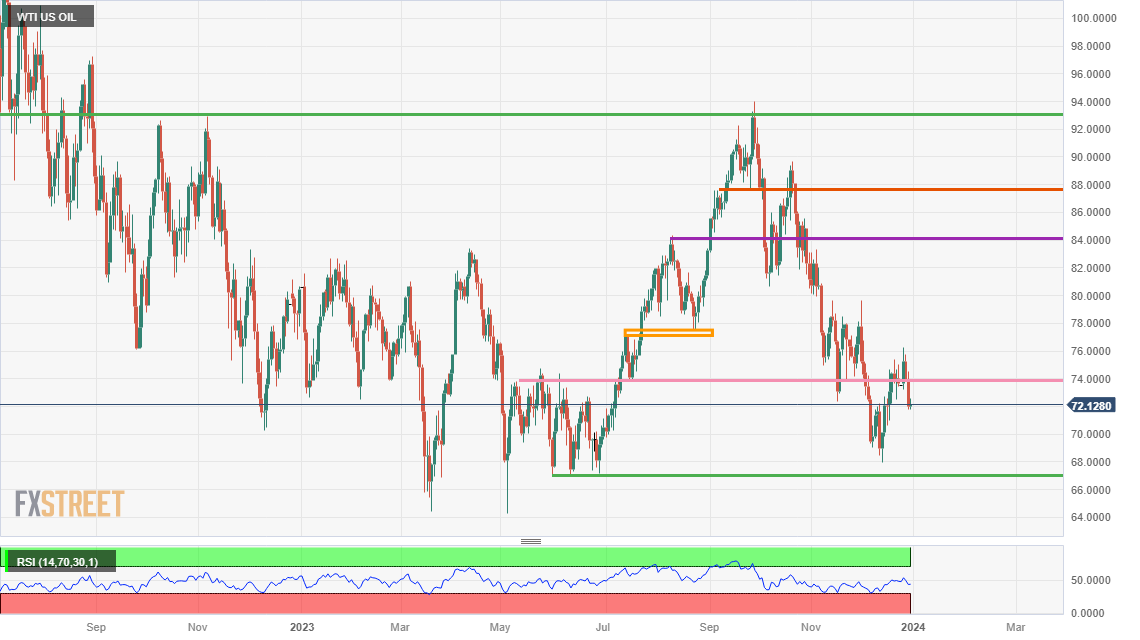Oil recovers a little ahead of the last trading session for 2023.
- WTI Oil drops back below $74, under important support.
- API overnight print was double the previous build.
- The DXY US Dollar Index sells off further and snaps below 101.
Oil prices are trying to recover a little bit with support coming in ahead of the very last US trading session for 2023. One thing that becomes very clear for this year, is that the OPEC+ mismanagement and internal struggle has had a negative effect on the oil prices. For 2023 both Brent and WTI are due to close with an overall negative performance of -10% for 2023, despite the heigthened geopoltical stakes.
The US Dollar (USD) meanwhile is back in green numbers on this very last trading day of 2023, adding a bearish bias to Dollar-denominated Oil. The turnaround comes on the back of still steady tight Jobless Claims in the US in both the continuing and initial Claims. This is reining in rampant interest-rate cutting speculation. Meanwhile traders are cleaning up their trading sheets and are closing their US Dollar short positions, which is triggering a demand of the Greenback in order to close off those positions.
Crude Oil (WTI) trades at $72.62 per barrel, and Brent Oil trades at $77.84 per barrel at the time of writing.
Oil News and Market Movers: A year in red thanks to OPEC
- Saudi Aramco has offered discounts on its February prices by $1.25 per barrel. The discounts are applicable on their Asian sales.
- US Crude inventories took a nosedive move of 7.11 million barrels on Thursday. The biggest one-week drawdown since August.
- The Pentagon is trying to provide assurances for shipping companies to pass via the Red Sea and Suez Canal again. Meanwhile Reuters report a Panama-flag ship carrying Wheat struck a mine in the Red Sea near Danube River.
- Russia has launched a new missile attack on Ukraine, targeting key cities in the country with heavy casualties.
Oil Technical Analysis: Geopolitics to dominate in 2023
Oil prices were unable to jump higher after the biggest drawdown of the US stockpile since August. The fact that Oil cannot advance even on such a chunky decline with the knowledge that the reserve needs to be refilled again, means that markets are more concerned about Saudi Arabia. The fact that the country, one of the OPEC+ countries which bears supply cuts, is selling Crude at a discount, means that OPEC+ is losing further control and grip on the Oil market.
On the upside, $74 is still holding some importance, although the level has become very chopped up. Once back above there, $80 comes into the picture. Although still far off, $84 is next on the topside once Oil sees a few daily closes above the $80 level.
Below $74, the $67 level could still come into play as the next support level to trade at as it aligns with a triple bottom from June. Should that triple bottom break, a new low for 2023 could be close at $64.35 – the low of May and March – as the last line of defence. Although still quite far off, $57.45 is worth mentioning as the next level to keep an eye on if prices fall sharply.

US WTI Crude Oil: Daily Chart
WTI Oil FAQs
What is WTI Oil?
WTI Oil is a type of Crude Oil sold on international markets. The WTI stands for West Texas Intermediate, one of three major types including Brent and Dubai Crude. WTI is also referred to as “light” and “sweet” because of its relatively low gravity and sulfur content respectively. It is considered a high quality Oil that is easily refined. It is sourced in the United States and distributed via the Cushing hub, which is considered “The Pipeline Crossroads of the World”. It is a benchmark for the Oil market and WTI price is frequently quoted in the media.
What factors drive the price of WTI Oil?
Like all assets, supply and demand are the key drivers of WTI Oil price. As such, global growth can be a driver of increased demand and vice versa for weak global growth. Political instability, wars, and sanctions can disrupt supply and impact prices. The decisions of OPEC, a group of major Oil-producing countries, is another key driver of price. The value of the US Dollar influences the price of WTI Crude Oil, since Oil is predominantly traded in US Dollars, thus a weaker US Dollar can make Oil more affordable and vice versa.
How does inventory data impact the price of WTI Oil
The weekly Oil inventory reports published by the American Petroleum Institute (API) and the Energy Information Agency (EIA) impact the price of WTI Oil. Changes in inventories reflect fluctuating supply and demand. If the data shows a drop in inventories it can indicate increased demand, pushing up Oil price. Higher inventories can reflect increased supply, pushing down prices. API’s report is published every Tuesday and EIA’s the day after. Their results are usually similar, falling within 1% of each other 75% of the time. The EIA data is considered more reliable, since it is a government agency.
How does OPEC influence the price of WTI Oil?
OPEC (Organization of the Petroleum Exporting Countries) is a group of 13 Oil-producing nations who collectively decide production quotas for member countries at twice-yearly meetings. Their decisions often impact WTI Oil prices. When OPEC decides to lower quotas, it can tighten supply, pushing up Oil prices. When OPEC increases production, it has the opposite effect. OPEC+ refers to an expanded group that includes ten extra non-OPEC members, the most notable of which is Russia.